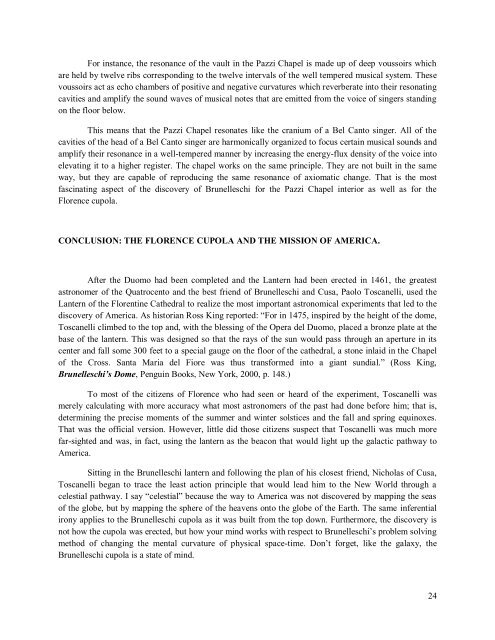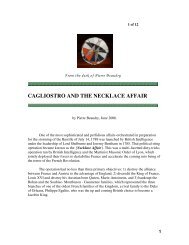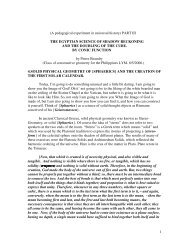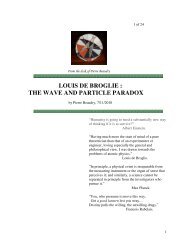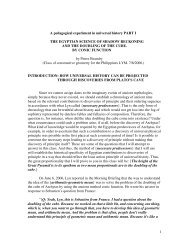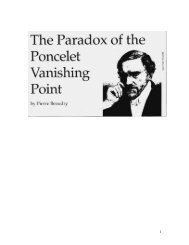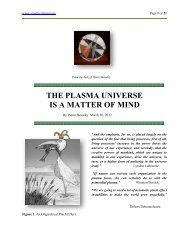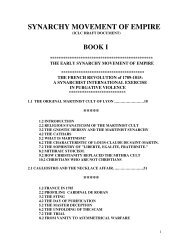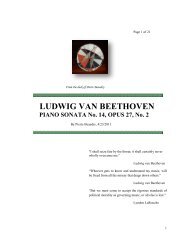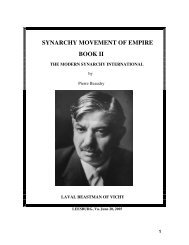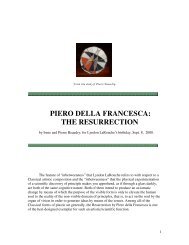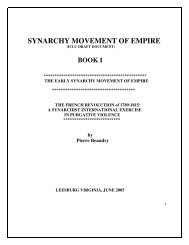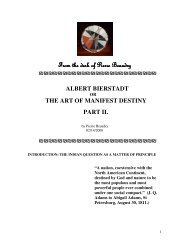filippo brunelleschi's mind and the catenary principle - Pierre ...
filippo brunelleschi's mind and the catenary principle - Pierre ...
filippo brunelleschi's mind and the catenary principle - Pierre ...
You also want an ePaper? Increase the reach of your titles
YUMPU automatically turns print PDFs into web optimized ePapers that Google loves.
For instance, <strong>the</strong> resonance of <strong>the</strong> vault in <strong>the</strong> Pazzi Chapel is made up of deep voussoirs whichare held by twelve ribs corresponding to <strong>the</strong> twelve intervals of <strong>the</strong> well tempered musical system. Thesevoussoirs act as echo chambers of positive <strong>and</strong> negative curvatures which reverberate into <strong>the</strong>ir resonatingcavities <strong>and</strong> amplify <strong>the</strong> sound waves of musical notes that are emitted from <strong>the</strong> voice of singers st<strong>and</strong>ingon <strong>the</strong> floor below.This means that <strong>the</strong> Pazzi Chapel resonates like <strong>the</strong> cranium of a Bel Canto singer. All of <strong>the</strong>cavities of <strong>the</strong> head of a Bel Canto singer are harmonically organized to focus certain musical sounds <strong>and</strong>amplify <strong>the</strong>ir resonance in a well-tempered manner by increasing <strong>the</strong> energy-flux density of <strong>the</strong> voice intoelevating it to a higher register. The chapel works on <strong>the</strong> same <strong>principle</strong>. They are not built in <strong>the</strong> sameway, but <strong>the</strong>y are capable of reproducing <strong>the</strong> same resonance of axiomatic change. That is <strong>the</strong> mostfascinating aspect of <strong>the</strong> discovery of Brunelleschi for <strong>the</strong> Pazzi Chapel interior as well as for <strong>the</strong>Florence cupola.CONCLUSION: THE FLORENCE CUPOLA AND THE MISSION OF AMERICA.After <strong>the</strong> Duomo had been completed <strong>and</strong> <strong>the</strong> Lantern had been erected in 1461, <strong>the</strong> greatestastronomer of <strong>the</strong> Quatrocento <strong>and</strong> <strong>the</strong> best friend of Brunelleschi <strong>and</strong> Cusa, Paolo Toscanelli, used <strong>the</strong>Lantern of <strong>the</strong> Florentine Ca<strong>the</strong>dral to realize <strong>the</strong> most important astronomical experiments that led to <strong>the</strong>discovery of America. As historian Ross King reported: “For in 1475, inspired by <strong>the</strong> height of <strong>the</strong> dome,Toscanelli climbed to <strong>the</strong> top <strong>and</strong>, with <strong>the</strong> blessing of <strong>the</strong> Opera del Duomo, placed a bronze plate at <strong>the</strong>base of <strong>the</strong> lantern. This was designed so that <strong>the</strong> rays of <strong>the</strong> sun would pass through an aperture in itscenter <strong>and</strong> fall some 300 feet to a special gauge on <strong>the</strong> floor of <strong>the</strong> ca<strong>the</strong>dral, a stone inlaid in <strong>the</strong> Chapelof <strong>the</strong> Cross. Santa Maria del Fiore was thus transformed into a giant sundial.” (Ross King,Brunelleschi’s Dome, Penguin Books, New York, 2000, p. 148.)To most of <strong>the</strong> citizens of Florence who had seen or heard of <strong>the</strong> experiment, Toscanelli wasmerely calculating with more accuracy what most astronomers of <strong>the</strong> past had done before him; that is,determining <strong>the</strong> precise moments of <strong>the</strong> summer <strong>and</strong> winter solstices <strong>and</strong> <strong>the</strong> fall <strong>and</strong> spring equinoxes.That was <strong>the</strong> official version. However, little did those citizens suspect that Toscanelli was much morefar-sighted <strong>and</strong> was, in fact, using <strong>the</strong> lantern as <strong>the</strong> beacon that would light up <strong>the</strong> galactic pathway toAmerica.Sitting in <strong>the</strong> Brunelleschi lantern <strong>and</strong> following <strong>the</strong> plan of his closest friend, Nicholas of Cusa,Toscanelli began to trace <strong>the</strong> least action <strong>principle</strong> that would lead him to <strong>the</strong> New World through acelestial pathway. I say “celestial” because <strong>the</strong> way to America was not discovered by mapping <strong>the</strong> seasof <strong>the</strong> globe, but by mapping <strong>the</strong> sphere of <strong>the</strong> heavens onto <strong>the</strong> globe of <strong>the</strong> Earth. The same inferentialirony applies to <strong>the</strong> Brunelleschi cupola as it was built from <strong>the</strong> top down. Fur<strong>the</strong>rmore, <strong>the</strong> discovery isnot how <strong>the</strong> cupola was erected, but how your <strong>mind</strong> works with respect to Brunelleschi’s problem solvingmethod of changing <strong>the</strong> mental curvature of physical space-time. Don’t forget, like <strong>the</strong> galaxy, <strong>the</strong>Brunelleschi cupola is a state of <strong>mind</strong>.24


